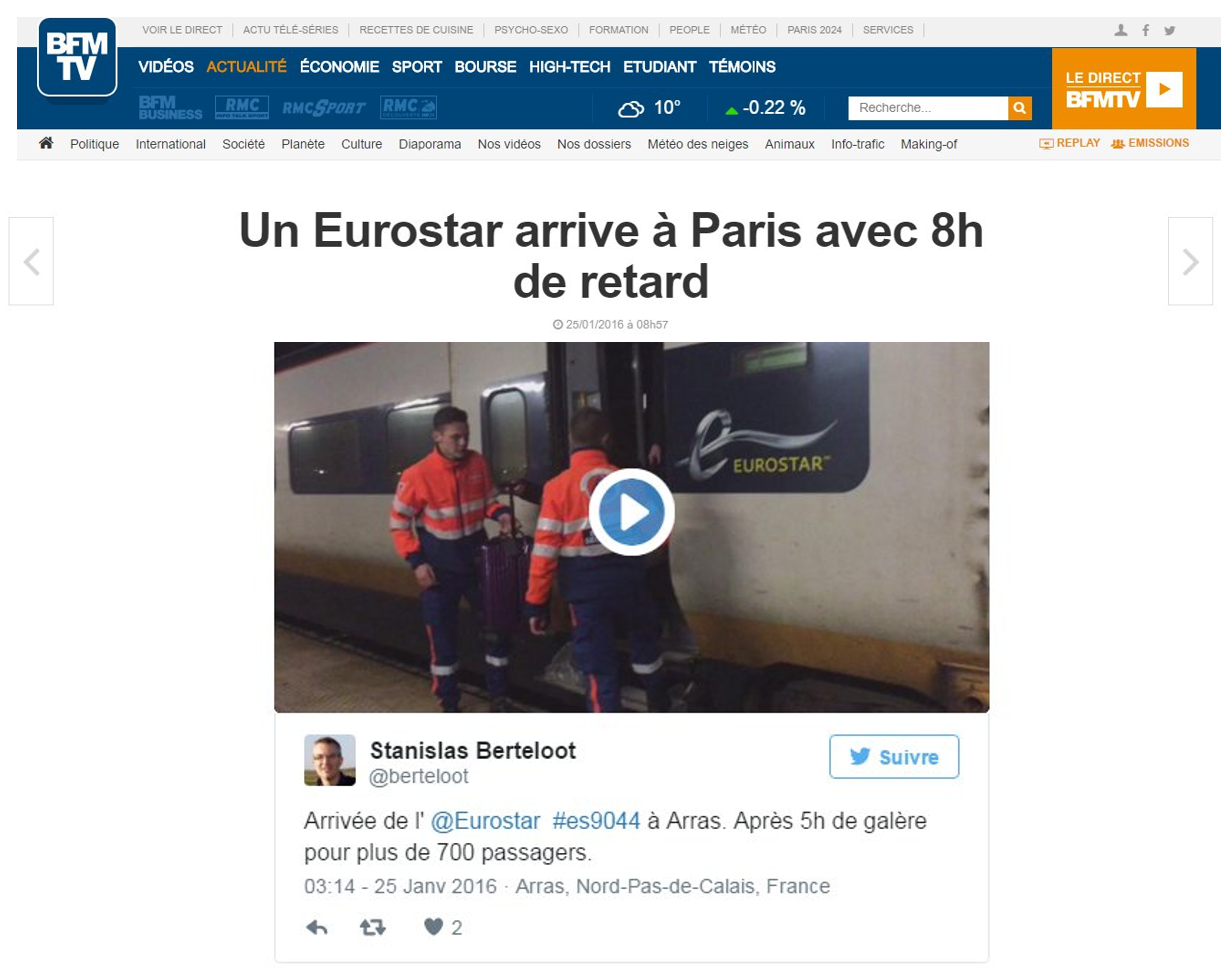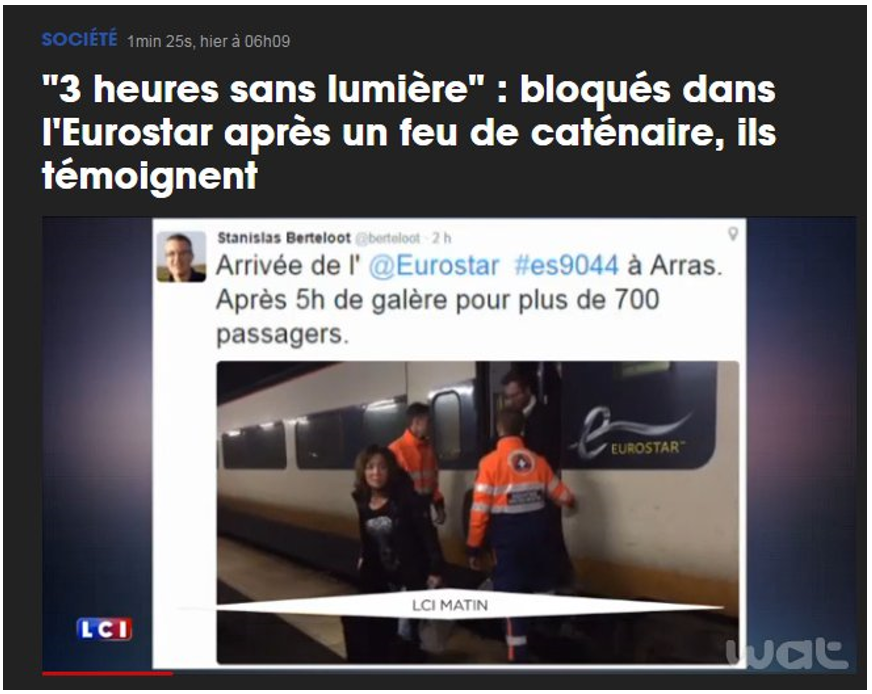How I used Social Media to Get my Story in the Media Across the World

Eurostar Fire: Stuck 11 hours on the Train, How I used Twitter & Social Media to Get my Story in the Media Across the World
Social Media PR Techniques and Strategies to Control your Business’ Reputation
How a Family Trip Turned into a Nightmare
I spent last weekend in London with two of my daughters aged 10 and 13. It was a fun father-daughter trip: A nice mix of cultural visits and shopping on Oxford Street.
We even stopped at Harrods for scones and tea… The girls loved it.
This weekend would have been perfect if the engine of our Eurostar hadn’t caught fire on the way back to Paris.
The train, which was scheduled to arrive Gare du Nord in Paris at 8:47 p.m. Sunday, got stuck in the middle of the French countryside for 8 hours before being towed to Arras where we had to transfer to another train at 2 a.m. to finally reached Paris shortly before 5 a.m. on Monday.
The Train From Hell
The train was packed with families, babies, and pregnant women. The fire had damaged the catenary system and the train’s batteries quickly ran out. No electricity meant no public system for announcements and updates, no light – we sat in the dark, no ventilation…
Despite its best attempts, Pierre, the Train Manager had a tough time informing the 700 passengers seating along the 17 carriages.
To make things worse the two carriages next to the engine in fire had to be evacuated and the people flocked the already crewed cars, seating on their luggage blocking the alleys.
Imagine 700 people trapped in the dark. The air was heavy and babies started crying. People felt dizzy. Buffets ran out of food and water. People grew frustrated and complained about the lack of information, although, I must say I was surprised at how calm most people were.
Reaching to the Outside World with Twitter
At 6 a.m. on Monday, three French national TV channels had broadcasted my videos – one TV channel included my recorded phone interview. A national radio had aired my three minutes interview and countless newspaper websites around the world had used my Tweets @Berteloot and videos on their reports.
This already huge coverage could have been even broader if I hadn’t gone to sleep and switched off my phone at 6 a.m. When I switched my phone back on at 11 a.m. I had several text messages, emails and Twitter notifications from radios and TV trying to interview me. I check the Web and LCI, iTELE, RTL, BFMTV, Le Figaro, Europe 1, M6, The Evening Standard all contacted me, have used my videos, my interviews or both!
 Watch Full Movie Online Streaming Online and Download
Watch Full Movie Online Streaming Online and Download
Here is how I made it happen:
The 6 rules of Twitter PR Engagement
1- Talk to People: use Twitter Handle
To have a chance to be noticed, always address someone by adding that person’s handle in your tweet. This way, you may get a reply or at least people that search for that Twitter handle may see your post.
People tend to reply when being talked to. Ask them a question, engage them and comment on what they have posted.
My first Tweet that evening read:
2- Join the Conversation: use Hashtag
Search Twitter to find which word(s) are used to organize the topic you are addressing. In my case, I notice that @Eurostar was using the #ES9044 hashtag to communicate about the incident. Hashtags are important since they turn any word of a group of words that directly follow the pound sign (#) into a searchable link.
3- Tweet often and Retweet
I posted 12 tweets within three hours before being first contacted by a journalist from LCI and during the entire incident I sent 41 tweets! There are about 6000 tweets sent every second… So if you want to stand a chance to be noticed, tweet often but remember to change your tweet content (Twitter won’t let you send twice the same tweet) and keep on using your topic’s hashtag and the handle of people you want to be noticed by.
Retweet the best content you find on your topic and “like” contents from people you want to be noticed by. Chances are they will return the favor and journalists will end-up noticing your tweets.
4- Use visuals to stand outWatch movie online The Transporter Refueled (2015)
I have read that tweets with a photo get 313% more engagement.
Although I cannot verify this statistic, I can testify that the first journalist to contact me responded to a tweet of a photo.
I then tweeted a video that went viral as many publications and even TV channels used it (within its Twitter skin) in their report.
Images can also be a nice way to extend your 140 characters limit. You can also post infographics and stats, which are always popular on Twitter.
In addition to using visuals, add links to your tweets as they increase your chances to be noticed and retweeted.
5- Live in the Instant
When a journalist wants to engage with you don’t think twice as you may lose your chance of getting quoted.
Four things you need to do very quickly when contacted on Twitter:
- Follow the users
- Ask them to follow you (journalists will probably already have done so)
- Send them your phone number via direct message (DM)
- If the journalist contacting you is not used to working with Twitter you can post your number and then delete your tweet soon after? But remember that whatever you do don’t waist anytime as the journalist is on deadline and if you don’t reply someone else will!
6- Make Things Simple
Help yourself by making a journalist’s life easier. If you want to increase the odds of getting a journalist to write about your story you’ve got to make it incredibly easy for her to do so.
Stuck on the Eurostar the only thing I had was my iPhone 6 and my Anker 13000mAh external battery (enough juice to last a long, long time…).
If like I was, you are lucky enough to have a good connection and a nice data plan you are in good shape.
Three things you must do to have your story covered in the press
Here are three important things to do to increase your chances to get your story covered:
- Have a story, a newsworthy story.
It needs to impact people, must be timely and you need to pitch it to the right journalist. Get your facts right. In the train, I meticulously kept track of time at each step of the incident. I used Google map to locate the incident and reported only official sources.
Before giving the interview, I paused and organized my thoughts. What was it I wanted to say? What story would be interesting to people hearing that a train had caught on fire? Every story has several angles to it. I had to decide which angle I wanted to take on my Eurostar adventure. - Provide illustrations.
Our smartphone is now capable of producing high-resolution videos and photos. Here are a few tips: Record in a horizontal position! That’s the single most important tip!
Now here are bonuses:
Film scenes that speak for themselves. I didn’t film people in the cars as it could have been just about any car but I filmed the rescue team helping people out of the train. I filmed rescue team distributing water bottles to thirsty passengers…
Film date, time and places that can clue-in your audience and make your film more factual. In my case it was easy: Eurostar logo on the train, station clock showing arrival time at Gare du Nord… - Make your content available.
All your video clips and photos won’t be much used if they stay in your phone to make them available. I had opted for Google Drive. I created a folder “Eurostar” and uploaded my HD pictures and videos. I then asked journalists for their email and shared the folder. I could also have shared the link to the folder. Dropbox is another great option to share content; you can easily post all of your materials on the ‘Public’ folder for example.
I also posted some of the best video clips on Twitter. If you have the time you should edit your clips (you can use iMovie on your iPhone to do it) and post the edited video on YouTube sharing the link on Twitter.
Strategies to Control your Business’ Reputation
Eurostar Fire is a perfect case study of online reputation and crisis management.
Four key takeaways from this incident:
Learnings from Eurostar:
24/24-community management. Engage in a conversation. Eurostar did a fantastic job both online and offline. On Twitter, @Eurostar started to engage very quickly with Twitter users. Using the #ES9044 hashtag they addressed people by their Twitter handle and provided friendly, factual updates about the situation throughout the night. @Eurostar did a good job at apologizing, saying thanks, or just showing empathy and joining the conversation as a human. @Eurostar is indeed now fully social media matured!
The Twitter feed was a nice support to the train staff overwhelmed by upset passengers. Staff had to go up and down the cars providing updates to travelers.

On the train, the team did a good job. The Train Manager introduced himself as Pierre which made his addresses more personal. People in the train appreciated his factual and professional yet casual style.
Areas for improvement: Pierre should at times have provided clearer orders. Orders which could not have been misinterpreted. Also, remember that when in doubt, leave it out. Eurostar should also have avoided fear-inducing sentences such as “you are totally safe in the train” which the train manager repeated often and that passengers started to question.
Note: Eurostar has recently decided to internalize its social media community management, that’s indeed a great move. Having internal staff on Twitter means more knowledge of the internal situation and more responsiveness in time of crises.
Be transparent. Even when you are wrong being straightforward, transparent and friendly can sometimes turn an angry customer into a fan.
Learnings from the media
PR is dead: media go directly to the source. One of the takeaway for businesses here is that corporations should encourage their staff and management to develop their online presence.
Of course, the Eurostar Fire incident is not relevant to every PR situations but the fact remains: journalists, whenever possible, will try to bypass the PR spin doctor and the marketing department to reach out directly to their sources.
By trusting your employees to speak out publicly your organization will maximize its outreach and increase opportunities to be heard. Now, if you managed to get your top management to tweet, make sure you organize a media training session before they start speaking to the press.
News doesn’t wait
Again if we look at the Eurostar Fire incident it is interesting to note that I obviously wasn’t the only guy on Twitter that night, others were asked to testify. I was, however, very quick to respond and to provide quality content. That made the difference.
The same true with corporate PR and unless a journalist has been assigned to write a profile on your CEO or your company, you won’t be the only interviewed and if you delay your reply journalists will find someone else to quote.



